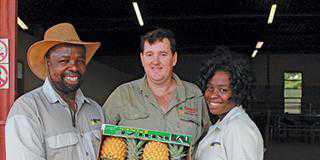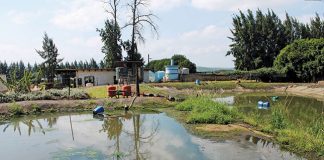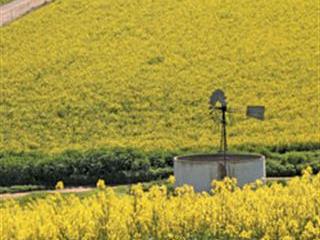
When he first started farming with canola about 17 years ago, it wasn’t easy, recalls AJ Louw of Tweekuil Farmss in Malmesbury in the Swartland. But the thing about farming, he adds, is although you only get one chance every year to get things right, you get another chance the following year. And AJ stuck with canola because he believed in its benefits as an alternative cash crop in the wheat-medics rotation cycle common in the Swartland.
In addition, says AJ, who farms in partnership with his brother Llewellyn on about 1 700ha of arable land (700ha of this is rented), by including canola in their crop rotation system, they can increase the yield of their wheat crop in the follow-up year. Now one of South Africa’s most experienced canola farmers, AJ did well at the 11th annual Canola Competition for 2011 presented by the Western Cape Department of Agriculture and the Protein Research Foundation (PRF).
At 2,55t/ha, he achieved the highest yield and also won the prize for the best gross profit margin of R6 058/ha. He accomplished this by planting CB Jardee cultivar seed during the third week of April 2011. At the time of sowing, the lands were dry and the seed was sown at a density of 3kg/ha. “Cultivar choice is one of the most important aspects of successful canola production. Farmers should choose cultivars that are suited to the area in which they farm and would fit in best with their production cycle,” says AJ.
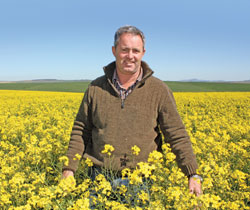
AJ Louw of Tweekuil Farms in Malmesbury won the prizes for the highest yield and gross profit margin in the 2011 Canola Competition.
“I’ve planted many different cultivars over the years, from the conventional to the new hybrids, but I was very impressed with the results achieved with the CB Jardee triazine tolerant hybrid I planted last year – so much so I planted the same variety again this year.” The seed of the hybrid cultivars costs about double that of conventional varieties, but AJ says it’s worth every cent, and he’s expecting very good yields again this year.
“I base my decision about how much canola to plant on the wheat price and the state of my lands,” he explains. “If the wheat price is good, I plant more wheat, but if the weed pressure gets too high in a certain camp, I’ll introduce canola into the rotation cycle in an attempt to bring the weeds under control.” AJ usually decides how much canola he’ll plant in November, after the harvest. In 2011 he planted about 1 200ha wheat and 100ha canola.
This year he’s increased the canola planting to 330ha, partly due to the fact that he had more land available after deciding to lease additional land on a neighbouring farm. “Most of our arable land is under a wheat-medics rotation cycle, but we also plant a small amount of oats as feed for our livestock,” says AJ.
Diversification
“We believe in the merits of diversification as a way to spread our risk,” he notes. Aside from canola as an alternative cash crop in their wheat-medics rotation cycle, AJ and Llewellyn also farm beef cattle and sheep. “Wheat is planted every second year and rotated with canola, oats or medics,” he adds. Medics is very important because it helps improve soil health by fixing nitrogen in the soil.
As a cover crop it also helps to reduce disease and control weeds, and produces a good forage yield. This year, in addition to 330ha of canola, AJ planted 600ha wheat and 200ha oats. “I try to repeat the canola rotation per land every four years but it really depends on the weed and disease pressure in the wheat.”
AJ conducts soil analyses once every two years after the harvest, to determine his fertiliser and liming needs. He then starts applying lime in January. He uses either calcitic or dolomitic lime and usually tries to apply lime during the medics rotation according to the needs of the soil, but he says he never applies more than 2t/ha.
Planting
“We start planting canola in April,” says AJ. “But if it rains before then, and the weeds start growing before we plant, I’ll spray the weeds with a broad spectrum herbicide, such as a glyphosate or a paraquat-based herbicide, before planting. “These two herbicides are used on an alternating basis to stem the spread of glyphosate resistance in weeds,” he adds. AJ practices no-till planting and uses a planter with an inter-row spacing of 300mm.
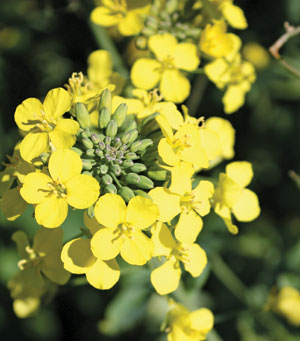
While the seed for the hybrid canola cultivars is more expensive, AJ planted only 3kg of this seed per hectare compared to the 4kg or even 5kg of seed he would’ve needed to achieve similar yields if he planted conventional cultivars.
Using the planter makes it possible to prepare the soil and plant in one pass, with the seed, fertiliser and herbicide sowed or applied directly to the stubble of the previous crop. “At planting I apply granular fertiliser,” says AJ. “This year I used 20kg/ ha of nitrogen (N), 10kg/ha of phosphorus (P) and 7kg/ha of sulphur (S). “I also apply a pre-emergence herbicide such as Trifluralin at planting to suppress annual grasses, most notably ryegrass, and broadleaf weeds.”
About one month after planting, AJ applies a selective systemic herbicide such as Atrazine or Simazine to control weeds. With this he applies Dimethoate, an organophosphorus insecticide that kills mites and insects systemically. “I do a top-dressing at the beginning of stem elongation,” continues AJ. “This year I applied 150kg/ha of granular fertiliser which contained 60kg N and 9kg S just before flowering. I also applied the trace elements boron and molybdenum.”
Harvesting
Timing is everything when harvesting canola. It can be harvested directly or ?rst swathed and then threshed – a technique mainly used in areas where the canola is more likely to suffer pod shatter or wind damage. AJ suggests that farmers should use the technique that bests suits conditions in the area where they farm and the machinery that’s available.
“We’ve stopped swathing and started using defoliants by way of aerial spraying. The defoliant is sprayed at around 14 to 28 days after ?owering is complete or when fewer than 10% of the ?owers are still visible. “We have to start harvesting within five to seven days after the defoliant has been applied and therefore we spray only as much of the canola with the defoliant as we can handle at a time.”
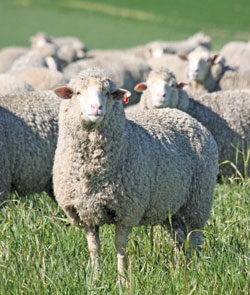
As part of their diversification, the Louw brothers also farm with a Dohne Merino flock consisting of about 750 ewes.
Information
Farmers who have never planted canola before must not make the mistake of thinking it’s easy to grow. Instead, they must endeavour to learn as much about canola as they can before they start planting it, says AJ. “There’s a wealth of information available, you must just go to the trouble of accessing it,” he adds. A good starting place is the Protein Research Foundation’s Canola Manual. “Then attend the information days hosted in your area and stay abreast of new developments, especially cultivar releases.”
Passport
New farmers must also make sure their Canola Passport is up to date. This is a document containing all the details about chemicals used on the canola plant which a farmer must present when they deliver canola to the Southern Oil canola processing facility in Swellendam.
To summarise, canola “requires intense and dedicated production management,” says AJ. However, those new to the business should not lose hope too soon if their first few attempts don’t yield wonderful results, he adds. It’s worth it, says AJ, because canola “has great potential, not only to help control weeds and increase wheat yields, but also as a cash crop in its own right.”
Contact AJ Louw on 082 321 1681 or [email protected]. For more information about the Canola Manual contact
the Protein Research Foundation on 011 803 2579 or [email protected].












